
The FG 42 is a selective-fire 7.92×57mm Mauser automatic rifle produced in Nazi Germany during World War II. The weapon was developed specifically for the use of the Fallschirmjäger airborne infantry in 1942 and was used in very limited numbers until the end of the war.
The M60, officially the Machine Gun, Caliber 7.62 mm, M60, is a family of American general-purpose machine guns firing 7.62×51mm NATO cartridges from a disintegrating belt of M13 links. There are several types of ammunition approved for use in the M60, including ball, tracer, and armor-piercing rounds.

The Beretta 92 is a series of semi-automatic pistols designed and manufactured by Beretta of Italy. The Beretta 92 was designed in 1975, and production began in 1976. Many variants in several different calibers continue to be used to the present.

The M240 machine gun, officially the Machine Gun, 7.62 mm, M240, is the U.S. military designation for the FN MAG, a family of belt-fed, gas-operated medium machine guns that chamber the 7.62×51mm NATO cartridge.
The PP-19 Bizon is a 9×18mm Makarov submachine gun developed in 1993 by the Russian company Izhmash. The Bizon was designed by a team of engineers headed by Victor Kalashnikov and including Alexei Dragunov.

The FN MAG is a Belgian 7.62 mm general-purpose machine gun, designed in the early 1950s at Fabrique Nationale (FN) by Ernest Vervier. It has been used by more than 80 countries and it has been made under licence in several countries, including Argentina, Canada, Egypt, India and the United Kingdom.

The PK is a belt-fed general-purpose machine gun, chambered for the 7.62×54mmR rimmed cartridge.

The Stoner 63 is a 5.56×45mm NATO modular weapon system. Using a variety of modular components, it can be configured as an assault rifle, carbine, top-fed light machine gun, belt-fed squad automatic weapon, or as a vehicle mounted weapon. Also known as the M63, XM22, XM23, XM207 or the Mk 23 Mod 0 machine gun, it was designed by Eugene Stoner in the early 1960s. Cadillac Gage was the primary manufacturer of the Stoner 63 during its history. The Stoner 63 saw very limited combat use by United States forces during the Vietnam War. A few were also sold to law enforcement agencies.

The M1901 Mannlicher Self-Loading, Semi-Automatic Pistol was an early semi-automatic pistol design. The Bundeswehr Museum of German Defense Technology in Koblenz has one of these specimen in its collection.
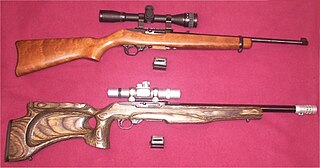
Accurizing is the process of improving the accuracy and precision of a gun.

The Heckler & Koch P2000 is a German semi-automatic pistol introduced late in 2001 and intended primarily for law enforcement, paramilitary, and commercial markets. It is based on the USP Compact pistol. The P2000 was designed specifically with improved ergonomic characteristics; it has features that reduce handling related stresses, while at the same time increasing user handling and comfort.

The Stechkin or APS is a Soviet selective fire machine pistol chambered in 9×18mm Makarov and 9×19mm Parabellum introduced into service in 1951 for use with artillery and mortar crews, tank crews and aircraft personnel, where a cumbersome assault rifle was deemed unnecessary. Seeing service in a number of wars such as the Vietnam War, Russo-Ukrainian War and Syrian Civil War. The APS was praised for its innovative concept and good controllability for its size. However, the high cost of the weapon, complex and time-consuming machining, combined with a limited effective range, large size and weight for a pistol, and fragile buttstock have been mentioned as a reason to phase it out of active service in favour of assault rifles such as the AKS-74U. The pistol bears the name of its developer, Igor Stechkin.
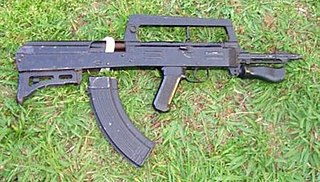
The Norinco Type 86S is an AKM-type bullpup rifle that was produced by Norinco. Many major parts are interchangeable with other standard Kalashnikov rifles.

The Smith & Wesson M&P is a polymer-framed, short recoil operated, locked breech semi-automatic pistol introduced in the summer of 2005 by the American company Smith & Wesson. It uses a Browning-type locking system. While targeted at law enforcement agencies, the M&P is also widely available on the commercial market.
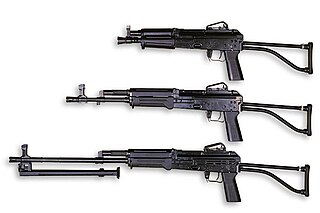
The ČZ 2000 is a prototype 5.56 mm caliber Czech weapon system, consisting of a standard rifle, carbine and light machine gun. The system was developed in 1991 after adapting the LADA firearm prototype J. Denel from the Brno-based Prototypa-ZM company is the chief designer for both systems. The ČZ 2000 was to be produced by Česká zbrojovka of Uherský Brod. It was planned to be the new service weapon of the Czech Army, replacing: the 7.62 mm vz. 58 assault rifle, 7.65 mm vz. 61 Škorpion submachine gun and 7.62 mm vz. 59 machine gun. As of 2007, the project has been discontinued.
The following are terms related to firearms and ammunition topics.
The Type 77 is a 7.62×17 mm Type 64 caliber semi-automatic pistol in service with all branches of the People's Liberation Army (PLA) of the People's Republic of China, People's Armed Police and various Chinese police forces. The Type 77 has been the main sidearm of the PLA for over two decades and is slowly being phased out by the QSZ-92 pistol in both military and police service but is still in widespread use across the country amongst second line military units and provincial police forces. Beginning in 1990, several variants of the Type 77 were developed for the international market.
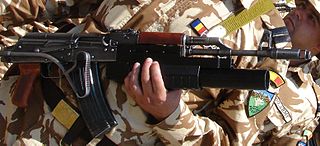
The Pușcă Automată model 1986 is the standard assault rifle used by the Romanian Military Forces and manufactured in Cugir, Romania by the ROMARM firm, located in Bucharest. The export name for this variant is the AIMS-74.
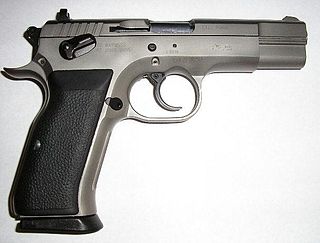
The Tanfoglio Combat or Standard, also known as T(A)95 or EAA Witness Steel, is a modified clone of the Czech CZ-75/CZ-85 pistol. It is made in Gardone Val Trompia near Brescia, Italy by Fratelli Tanfoglio S.N.C.
Colt Defender Mark I was an American multi-barreled shotgun intended for law enforcement or military use, completed in 1967. The shotgun was essentially a volley gun with eight single-shot barrels — each chambered for the 20-gauge 3-inch magnum shell — arranged in a octagonal fashion around the central axis, and could fire eight individual times like a semi-automatic action without the complexity of actually being a semi-automatic firearm. The action ran on a revolver-like rotating striker mechanism. The gun had a detachable buttstock and a pistol grip with a double-action trigger, and had a separate foregrip up front for instinctive shooting.
















